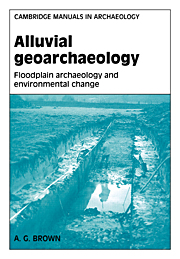Book contents
- Frontmatter
- Contents
- List of illustrations
- List of tables
- Preface
- Acknowledgements
- Introduction and the example of the Nile
- PART I PRINCIPLES
- PART II APPLICATION
- 5 Artifacts from floodplains and rivers
- 6 The rise and fall of forested floodplains in North-West Europe
- 7 Buried sites
- 8 Managed floodplains
- 9 The cultural archaeology of floodplains
- 10 People, floodplains and environmental change
- APPENDICES
- References
- Subject Index
- Index of rivers and sites
8 - Managed floodplains
Published online by Cambridge University Press: 03 December 2009
- Frontmatter
- Contents
- List of illustrations
- List of tables
- Preface
- Acknowledgements
- Introduction and the example of the Nile
- PART I PRINCIPLES
- PART II APPLICATION
- 5 Artifacts from floodplains and rivers
- 6 The rise and fall of forested floodplains in North-West Europe
- 7 Buried sites
- 8 Managed floodplains
- 9 The cultural archaeology of floodplains
- 10 People, floodplains and environmental change
- APPENDICES
- References
- Subject Index
- Index of rivers and sites
Summary
The almost imperceptible shift from the opportunistic utilisation of resources to the management and control of those resources is composed of many human innovations. Alluvial environments can be seen as one of the key environments for innovations including: irrigation, river, road and bridge engineering, and drainage. Of these, irrigation is generally regarded as being both the earliest and the most important in socioeconomic and political terms. While this is not the place to cover the history of irrigation, drainage or river training (see Biswas, 1970; Purseglove, 1989; Sheail, 1988), the relationship between floodplain exploitation and management is highly relevant to alluvial sites, and so will be considered here.
Flood farming and irrigation
The origins of irrigation are generally associated with the civilisations of the great alluvial valleys of Mesopotamia (Tigris and Euphrates), Egypt (Nile), India (Indus) and China (Hwang-Ho). These societies, which are associated with distinctively hierarchical modes of production, transformed their physical environments by the control of water. In the Euphrates valley, the control of water levels – high enough for seed germination but low enough to avoid damage – has its origins in floodwater farming during the Neolithic. A site at the edge of the floodplain at Chogi Mami, dated to 7500 bp, provides probably the earliest evidence of irrigation canals (Roberts, 1989). Later occupation of the floodplain (6500 bp) took place on levees and allowed the abstraction of water through the levees down onto the flood basins, the edges of which could be used for crops.
- Type
- Chapter
- Information
- Alluvial GeoarchaeologyFloodplain Archaeology and Environmental Change, pp. 254 - 278Publisher: Cambridge University PressPrint publication year: 1997



